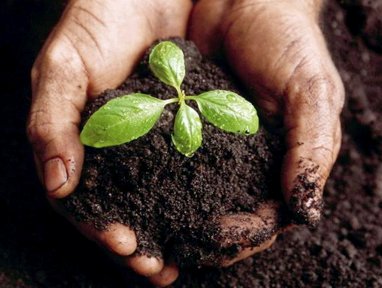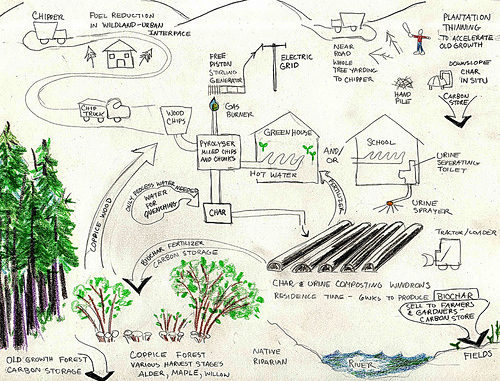Biochar: Difference between revisions
No edit summary |
No edit summary |
||
| Line 14: | Line 14: | ||
cost-effective utilization of urban, agricultural and forest co-products | cost-effective utilization of urban, agricultural and forest co-products | ||
Some of the world's most productive soils (e.g. US Midwest, Russian [http://en.wikipedia.org/wiki/Chernozem Chernozem] / "black earth") are very rich in carbon. This is now recognized to be largely pyrogenic in origin, likely originating from prairie or forest fires. The black carbon is often thousands of years old, demonstrating its stability in soil. For more extensive background on Biochar, please refer to the [http://en.wikipedia.org/wiki/Biochar Wikipedia entry] | |||
| Line 31: | Line 26: | ||
=Biochar in the OSE context= | =Biochar in the OSE context= | ||
So how does Biochar fit into the OSE scope and product ecology ? | |||
soil amelioration, degraded land, | soil amelioration, degraded land, | ||
| Line 38: | Line 36: | ||
efficient use of biomass waste for energy generation | efficient use of biomass waste for energy generation | ||
reduced need for land = | reduced need for land = lower startup costs for a Global Village | ||
biochar and charcoal: need charcoal anyway for other purposes, e.g. metal smelting, so might as well build a kiln | biochar and charcoal: need charcoal anyway for other purposes, e.g. metal smelting, so might as well build a kiln | ||
pyrolysis gas: can be used for energy, as heat source for heating greenhouses, | |||
[http://openfarmtech.org/index.php?title=LifeTrac Lifetrac] can be used to mix char into soil, till | |||
Biochar as a source of income for an emerging community. | |||
Charcoal for water purification and filtration. | |||
Pyrolysis gas: source of hydrogen, CO, small amounts of methane: for various processes | |||
Bio-oil: pyrolysis oil | |||
=Specifics= | =Specifics= | ||
pyrolysis | pyrolysis ... at 500C | ||
soil: up to 25% char appears to be beneficial | soil: up to 25% char appears to be beneficial | ||
Please refer to the [http://biochar.pbwiki.com/ Gardening with Biochar FAQ], an excellent resource. | |||
=Links= | =Links= | ||
Wikipedia entry on [http://en.wikipedia.org/wiki/ | Wikipedia entry on Biochar [http://en.wikipedia.org/wiki/Biochar] | ||
Gardening with Biochar FAQ [http://biochar.pbwiki.com/] | |||
BioEnergy Lists: Terra Preta (Biochar) [http://terrapreta.bioenergylists.org/] | BioEnergy Lists: Terra Preta (Biochar) [http://terrapreta.bioenergylists.org/] | ||
International Biochar Initiative (IBI) [http://www.biochar-international.org/] | |||
Biochar Fund [http://biocharfund.com/] | Biochar Fund [http://biocharfund.com/] | ||
[[Category:OSA]] | [[Category:OSA]] | ||
Revision as of 04:07, 18 January 2009
Background
[this article is still a work in progress, a mess]
Biochar helps mitigate the greenhouse effect by 1.) replacing fossil fuels from the energy landscape and 2.) and sequestering atmospheric carbon in a stable soil carbon pool. It can improve water quality by retaining fertilizers.
soil improvement
Part of the biochar process is the sustainable co-production of clean energy and other bio-based products.
Biomass in the agricultural sector of developing countries can be utilized efficiently.
cost-effective utilization of urban, agricultural and forest co-products
Some of the world's most productive soils (e.g. US Midwest, Russian Chernozem / "black earth") are very rich in carbon. This is now recognized to be largely pyrogenic in origin, likely originating from prairie or forest fires. The black carbon is often thousands of years old, demonstrating its stability in soil. For more extensive background on Biochar, please refer to the Wikipedia entry
The Biochar Economy
(image from Flickr user visionshare by CC license)
Biochar in the OSE context
So how does Biochar fit into the OSE scope and product ecology ?
soil amelioration, degraded land,
reduced need for fertilizers (e.g. manure), which is significant for the planned Permaculture Plantout at Factor e Farm.
increased biomass productivity efficient use of biomass waste for energy generation
reduced need for land = lower startup costs for a Global Village
biochar and charcoal: need charcoal anyway for other purposes, e.g. metal smelting, so might as well build a kiln
pyrolysis gas: can be used for energy, as heat source for heating greenhouses,
Lifetrac can be used to mix char into soil, till
Biochar as a source of income for an emerging community.
Charcoal for water purification and filtration.
Pyrolysis gas: source of hydrogen, CO, small amounts of methane: for various processes Bio-oil: pyrolysis oil
Specifics
pyrolysis ... at 500C
soil: up to 25% char appears to be beneficial
Please refer to the Gardening with Biochar FAQ, an excellent resource.
Links
Wikipedia entry on Biochar [1]
Gardening with Biochar FAQ [2]
BioEnergy Lists: Terra Preta (Biochar) [3]
International Biochar Initiative (IBI) [4]
Biochar Fund [5]

